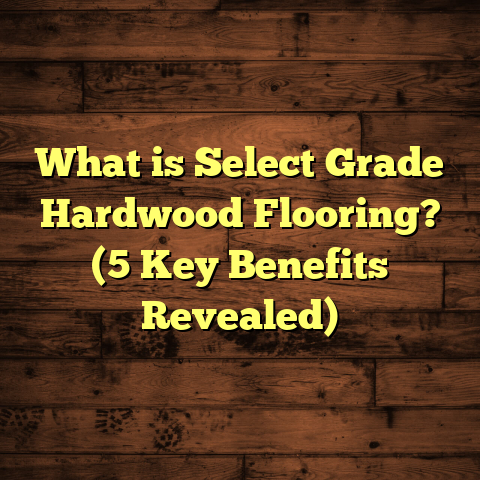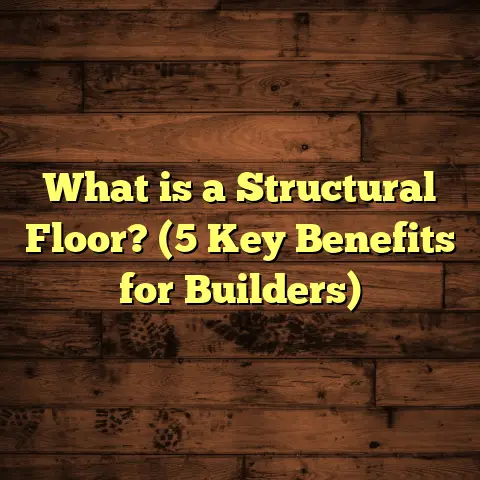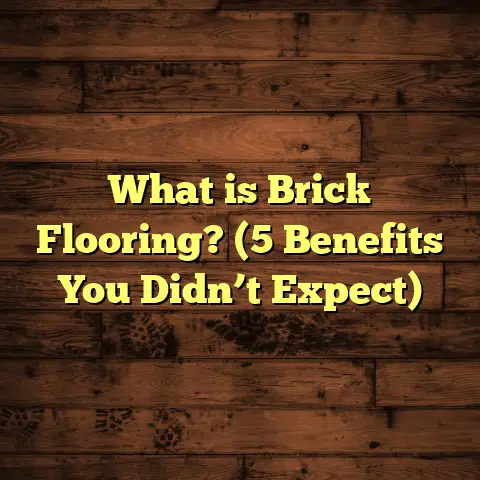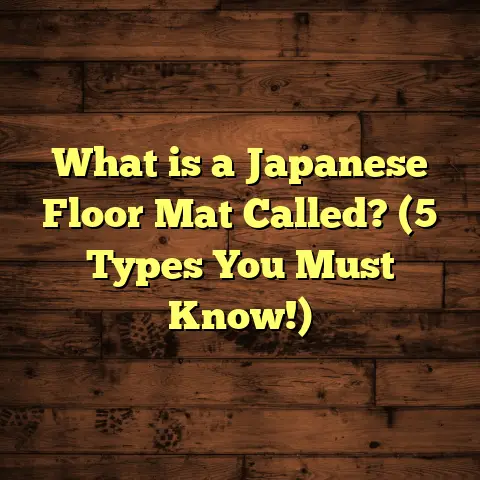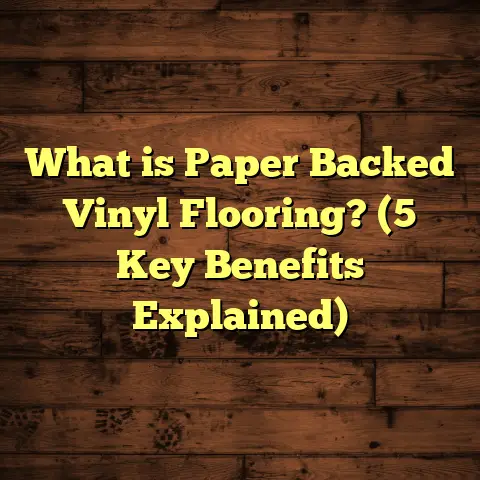What is Plank Flooring Made Of? (5 Key Materials Explained)
I’ve worked with many types of flooring over the years, and one thing I can say for sure is that plank flooring is one of the most versatile options out there. Whether you want a rustic farmhouse look or a sleek modern vibe, plank flooring can fit in almost anywhere. But what exactly is plank flooring made of? You might think it’s just wood planks, but there’s a lot more variety than that. Let me walk you through the five key materials that commonly make up plank flooring. Each has its own unique qualities, costs, and installation methods, so knowing these can help you pick the right one for your project.
What Is Plank Flooring?
Plank flooring refers to floor coverings made from long, narrow strips or “planks” that are installed side-by-side to cover the floor’s surface. The defining feature is the shape and size of the boards — usually wider and longer than traditional strip flooring. These planks can be made of different materials but the goal is always to create a continuous, visually appealing floor that can handle everyday wear.
When I first started in flooring, I assumed plank meant hardwood only. But over time, I realized plank flooring can be engineered wood, laminate, vinyl, and even tile designed to look like planks. This variety makes plank flooring popular for almost any room and budget.
Let me break down the five main materials used in plank flooring, sharing some personal insights and data that might help you decide which is best for your space.
1. Solid Hardwood
Solid hardwood is the classic choice for plank flooring. It’s made from a single piece of natural wood — oak, maple, hickory, or walnut are common species. Because it’s solid wood all the way through, it can be sanded and refinished multiple times during its lifespan.
I remember installing solid hardwood in an old Victorian home; the deep grain and rich patina added so much character. Hardwood planks typically come in widths ranging from 3 to 8 inches and lengths from 2 to 7 feet.
What Makes Solid Hardwood Special?
Solid hardwood is prized because it comes straight from nature without any layering or synthetic backing. This means every inch of the plank is wood, which gives it strength and longevity. The wood’s grain patterns and color variations are unique to each board — no two planks are exactly alike.
The density of the wood species also affects its durability. For example:
- Oak: One of the hardest and most common woods used.
- Maple: Slightly harder than oak with a smooth grain.
- Walnut: Softer but prized for rich color.
- Hickory: Extremely hard with dramatic grain patterns.
I’ve seen oak floors last over 100 years in historic homes when properly maintained.
Installation Insights
Installing solid hardwood typically requires nailing or stapling down the planks onto wooden subfloors. It’s usually not recommended over concrete unless you use a moisture barrier. The installation process demands skill and precise tools like nail guns and moisture meters.
One project I worked on involved removing old tile and leveling the subfloor before installing solid oak planks. The prep work took longer than expected but was critical for a smooth finish without squeaks.
Maintenance and Longevity
With solid wood floors, regular sweeping and occasional damp mopping are enough to keep them looking great. Avoid soaking the floor with water because excessive moisture damages the wood.
Because you can sand and refinish solid hardwood multiple times (typically every 7-10 years), these floors can literally last a lifetime. Some refinishing jobs have saved floors that looked worn or scratched beyond hope.
Cost Breakdown
Solid hardwood is on the higher end regarding price. Material costs range from $8 to $14 per square foot depending on species and finish. Installation adds $4 to $8 per square foot due to labor intensity.
Still, many homeowners consider this an investment because it adds resale value — often recouping 70-80% of their costs when selling.
Real-World Case Study
In a recent job renovating a 1920s bungalow, we replaced worn-out carpet with solid oak plank flooring throughout the main living areas. The homeowner was thrilled with how the warm tones complemented their antique furniture.
Over two years, they reported minimal maintenance issues aside from routine cleaning and one minor refinishing touch-up after heavy furniture moves.
2. Engineered Hardwood
Engineered hardwood looks like solid wood on top but has a layered plywood or fiberboard core beneath a thin veneer of real hardwood. This design improves stability and moisture resistance.
When I worked on a condo project with fluctuating humidity levels, engineered hardwood was my go-to because it didn’t warp like solid wood could. The top layer is typically 1/16 to 1/8 inch thick but enough for one or two refinishes.
Construction Details
The layers beneath engineered hardwood are usually cross-laminated plywood or high-density fiberboard (HDF). This cross-layering technique reduces dimensional changes caused by moisture or temperature swings.
The thin hardwood veneer on top provides the authentic look and feel of real wood without the full cost or installation limitations of solid planks.
Why Choose Engineered Hardwood?
- Moisture Resistance: Much better than solid wood in kitchens, basements, or over concrete slabs.
- Installation Flexibility: Can be glued down, nailed, stapled or even floated.
- Cost Savings: Usually less expensive upfront than solid hardwood.
For example, a mid-range engineered oak floor might cost $5 to $10 per square foot for materials.
Installation Tips
One thing I always tell clients is not to skimp on acclimating engineered hardwood before installation. Letting the planks adjust to room temperature and humidity for 48-72 hours prevents surprises like buckling later.
I’ve installed engineered floors with click-lock systems over radiant heat in bathrooms — something impossible with solid wood. This versatility widened options for many homeowners I work with.
Durability and Maintenance
Engineered hardwood can be refinished but only a limited number of times due to thin veneer thickness — usually once or twice max. Beyond that, replacement is necessary if wear becomes too visible.
Keep cleaning simple with sweeping and damp mopping; avoid harsh chemicals or excessive water exposure.
Market Trends & Data
In North America, engineered hardwood now accounts for nearly 40% of all hardwood floor sales according to recent industry reports — a sign of growing consumer confidence in its performance.
3. Laminate Flooring
Laminate flooring is a synthetic product designed to mimic wood or stone appearance. It’s made by fusing several layers: a high-density fiberboard (HDF) core topped with a photographic applique layer and a clear protective wear layer.
I’ve installed laminate in many rental properties because it’s affordable and holds up well under high traffic. The click-lock installation system makes it easy to lay down without nails or glue.
How Laminate Is Made
Laminate starts with a dense fiberboard base providing structural support. On top sits a high-resolution photographic image replicating wood grain or stone patterns — sometimes indistinguishable at first glance from real wood.
A clear melamine resin layer protects this image from scratches, dents, stains, and fading under UV light.
Benefits That Attracted Me
When working on tight budgets or quick-turn projects, laminate often comes out as best value because:
- Installation Speed: Floating method means no drying time.
- Durability: Resists scratches better than many hardwoods.
- Affordability: Material prices range $1.50 to $4 per sq ft; installation adds about $1-$3 per sq ft if hired out.
I once replaced worn carpet in an Airbnb unit with laminate; guests appreciated how easy it was to clean after spills compared to carpet stains.
Downsides to Keep in Mind
One main limitation is moisture vulnerability — if water seeps under planks it can cause swelling or warping. This makes laminate unsuitable for bathrooms or basements prone to dampness unless special waterproof versions are used.
Another thing is that laminate doesn’t have the same “feel” as real wood — it tends to sound hollow underfoot and lacks warmth when touched.
Maintenance & Longevity
Regular dry sweeping is sufficient; occasional damp mopping with laminate-safe cleaners works well too. Laminate floors generally last 10-20 years depending on usage but can’t be refinished like hardwood.
Laminate in Numbers
According to industry data, laminate saw its biggest growth between 2000-2010 but sales plateaued afterward due to competition from vinyl plank flooring. Still, it holds steady as an option for budget-conscious buyers.
4. Vinyl Plank Flooring
Vinyl plank flooring (also called luxury vinyl plank or LVP) has exploded in popularity recently. It features vinyl layers with a photographic image layer that realistically mimics wood grain or stone textures. Many types are waterproof, making them perfect for kitchens, bathrooms, and basements.
I’ve seen vinyl plank become a favorite among families with kids and pets because it’s durable and easy to clean. There are also options with added cushioning underneath for comfort.
How Vinyl Plank Works
Vinyl plank usually has four layers:
- Wear Layer: Clear tough coating protects against scratches.
- Design Layer: High-resolution image of wood grain.
- Core Layer: Either rigid (WPC) or flexible vinyl providing stability.
- Backing Layer: Adds cushioning and moisture protection.
This construction makes it very flexible in terms of installation — it can be glued down or floated depending on product type.
Why Vinyl Plank Has Surged
The waterproof nature means no worries about spills or humidity damage — perfect for kitchens and bathrooms where other plank types struggle.
Prices range widely from $2 up to $7 per square foot depending on quality; installation costs are typically lower than hardwoods due to simpler methods.
I recently helped install vinyl plank in a basement rec room; my client loved how warm and quiet it felt compared to concrete slab previously exposed.
Environmental Considerations
Vinyl contains PVC plastic which raises sustainability questions — disposal issues and VOC emissions during installation concern some buyers trying to go green.
Some brands have started producing “greener” options free of phthalates and with recycled content though these remain niche currently.
Maintenance & Lifespan
Vinyl plank requires little upkeep beyond regular sweeping and occasional mopping with mild cleaners. It can last 10-20 years depending on wear but isn’t refinishable once damaged.
5. Bamboo Flooring
Bamboo is often grouped with hardwoods but technically it’s a grass that’s processed into planks. It’s prized for sustainability since bamboo grows much faster than traditional hardwood trees.
When I helped renovate an eco-friendly home, bamboo was the preferred choice because of its green credentials combined with good durability. Strand-woven bamboo is especially hard and suitable for high-traffic areas.
What Makes Bamboo Unique?
Unlike traditional hardwoods that come from slow-growing trees taking decades to mature, bamboo reaches harvest size within 5 years making it a renewable resource.
The manufacturing process involves slicing bamboo stalks into thin strips then compressing them under heat and pressure into solid planks or engineered boards.
Types of Bamboo Flooring
- Horizontal: Strips laid flat showing bamboo nodes; softer look.
- Vertical: Strips stood upright showing linear grain; more modern look.
- Strand-Woven: Bamboo fibers shredded then compressed making very hard planks (harder than oak).
In one job fitting bamboo floors at a yoga studio, the client appreciated its natural look plus environmentally responsible sourcing certified by FSC (Forest Stewardship Council).
Pros & Cons
Pros:
- Fast renewability supports sustainability goals.
- Hardness comparable or superior to many hardwoods.
- Unique aesthetic different from traditional woods.
Cons:
- Sensitive to moisture fluctuations causing warping if not sealed well.
- Quality varies widely depending on manufacturer.
- Price ranges $3-$9 per square foot; mid-range is common around $5-$6.
Comparing These Materials Side-by-Side
| Material | Avg Cost (Material) | Durability | Moisture Resistance | Refinishable | Installation Difficulty |
|---|---|---|---|---|---|
| Solid Hardwood | $8 – $14 / sq ft | Very High (50+ yrs) | Low | Multiple | Professional recommended |
| Engineered Hardwood | $5 – $10 / sq ft | High (20+ yrs) | Moderate | Limited | Moderate |
| Laminate | $1.50 – $4 / sq ft | Medium (10-15 yrs) | Low | No | Easy (DIY friendly) |
| Vinyl Plank | $2 – $7 / sq ft | High (10-20 yrs) | Very High | No | Easy (DIY friendly) |
| Bamboo | $3 – $9 / sq ft | High (20+ yrs) | Low to Moderate | Limited | Moderate |
Installation Tips I’ve Learned Over Time
No matter which plank material you choose, proper installation makes all the difference between a floor that lasts decades versus one that causes headaches within months.
Here are some tips I share often:
- Acclimate Materials: Let planks sit in your home environment for at least 48 hours before installation.
- Check Subfloor Levels: Uneven floors lead to squeaks and damage later — prep subfloor thoroughly.
- Use Moisture Barriers: Especially important over concrete slabs or in humid areas.
- Follow Manufacturer Instructions: Each material has specific adhesives, underlays, or expansion gap requirements.
- Hire Professionals When Needed: For materials like solid hardwood or complex layouts, expert installers save time and money long-term.
How I Use FloorTally for Cost Estimation
Cost estimating used to be one of my least favorite parts of flooring projects. Juggling material quotes, labor costs from subcontractors, waste factors — it was easy to miss something important.
Then I started using FloorTally for all my estimates. This tool lets me input room dimensions, choose from different materials and finishes, add local labor rates (which vary widely based on city), plus waste percentages customized by material type.
For example:
- When estimating costs for engineered hardwood in a 300-square-foot living room recently remodeled, FloorTally showed me total material plus labor around $3,600 including waste contingency.
- Switching materials quickly updated totals so I could compare vinyl plank vs engineered hardwood side-by-side without redoing spreadsheets manually.
It saves me hours every week and keeps client budgets realistic — no unpleasant surprises halfway through installation anymore!
Maintenance Tips Based on Material Choice
Keeping your plank flooring looking great depends partly on what you chose:
Solid Hardwood & Engineered Hardwood:
- Sweep daily or use microfiber dust mop.
- Clean spills immediately.
- Refinish every few years as needed.
Laminate:
- Avoid standing water.
- Use laminate-approved cleaning solutions.
Vinyl Plank:
- Mop regularly with mild detergent.
- Avoid abrasive scrubbers that damage wear layer.
Bamboo:
- Use pH-neutral cleaners only.
- Maintain indoor humidity between 40%-60% if possible.
Troubleshooting Common Issues I’ve Encountered
Some common problems come up across all plank types:
Cupping/Warpage: Usually caused by excess moisture below the floor or rapid humidity changes. Proper moisture barriers and acclimation help prevent this.
Squeaking: Often due to subfloor irregularities or loose fasteners—ensure subfloor prep before installation.
Scratches/Dents: Use rugs in high traffic areas; consider harder woods like hickory if pets are around.
If any issues arise post-installation, early intervention often limits damage—don’t wait months before addressing floor imperfections!
Final Thoughts From My Experience
Plank flooring comes in many forms beyond simple wood boards. Knowing what each material is made of helps clarify which fits your lifestyle best:
- Solid hardwood offers timeless beauty but needs careful care.
- Engineered hardwood balances looks with practicality.
- Laminate works well when budget matters most.
- Vinyl plank rules wet spaces.
- Bamboo appeals if sustainability is your priority.
Each material brings its own feel underfoot and behaves differently over time — so think about your family’s habits before deciding!
If you want help figuring out which plank flooring suits your needs or need tips on installation specifics for any material mentioned here, just ask! I’m happy to share what I’ve learned firsthand after installing thousands of square feet over the years.
Would you like me to expand on particular sections such as installation techniques, detailed maintenance routines, or real project stories? Just let me know!

